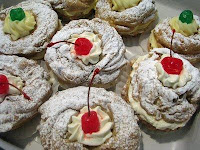 |
| Credit: Double Nickel Farm |
For many, Easter is synonymous with candy, marshmallow peeps, chocolate bunnies, coconut eggs, jelly beans, even pastel candy corn. When I was growing up, I looked forward to shopping for a spring coat, dress, and patent leather shoes. My brothers and I anxiously anticipated an end to this season of fasting and penance. We were starving for all the foods we gave up for Lent. One of my fondest Easter memories involves not candy but bread.
After a long Lenten season, my great-grandmother would celebrate the coming of Easter with a special bread. She started with a rich, brioche-like dough, shaped it into a braided ring, and tucked colored hard-boiled eggs into the spaces in the braid. For her great-granddaughters, she would make pocketbooks from the bread with a colored egg peeking out from the top. For her great- grandsons, she made long-eared bunnies holding an egg in its paws. Did anyone think to write down her recipe? Sadly, no.
The eggs in the bread made the children aware of this important symbol for Easter, which for my great-grandmother was truly a holy day. Eggs represent new life, and for Catholics, Easter is about the Resurrection, so eggs represent Christ's emergence from the tomb.
 |
| My brother Michael with our Easter frittata, a 50 egg omelet. |
This frittata is not fast food. Michael starts over an hour before we sit down. He carefully cracks fifty eggs into a huge bowl. He finely chops a whole bunch of Italian parsley. He grates orange rind. He adds a three-pound container of ricotta to the eggs and carefully breaks up the yolks and incorporates the cheese. He heats oil in the skillet until is sizzles when he drops a teaspoon of the egg mixture into the pan. And then it's time to pour the egg mixture into the oil, to carefully lift cooked egg to allow raw to seep underneath. Eventually, it's time to flip the frittata over, no feat for the timid, but Michael has never been accused of being a scaredy cat. And then it's time to serve this masterpiece to the oohs and aahs of everyone at the table. We'll say grace and be thankful for our family, and then savor the best frittata ever.
May you and your family have a happy and holy Easter Sunday.
Here is a scaled-down recipe for our family's frittata recipe:
Frittata
8 eggs
1 cup ricotta cheese
1 Tablespoon grated orange rind
1/4 cup chopped Italian (flat-leaf) parsley
pinch salt
generous grind of fresh pepper
2 Tablespoons canola oil
sprigs of parsley and thin slices of orange for garnish
Mix the eggs with a fork until the yolks are broken, then add the next 5 ingredients. Mix until well incorporated. Heat about half the canola oil in a medium skillet* until it sizzles when a drop of egg is added. Add the egg mixture. As the egg cooks, gently lift the cooked egg and allow the raw egg to run underneath. When the eggs are set but the top is still moist, remove the skillet from the heat, place a plate that is slightly larger than the skillet on top, and flip the frittata onto the plate. Remove any egg that is stuck to the bottom of the pan, wipe the pan clean, reheat with remaining oil. (Work quickly!) Slip the frittata back into the skillet, wet side down, and cook until the bottom is golden brown. Transfer the frittata to a clean plate, garnish with the parsley sprigs and orange slices. Serves two or three generously.
*Use a medium or even a small skillet so that the frittata is thicker than a standard omelet.




